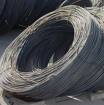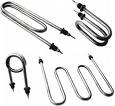Heating elements for electric resistance furnaces
Heating elements (heaters)
Zigzag wire heaters are hung from the walls and roof of the furnace on heat-resistant hooks, the hearth heaters are loosely placed on shaped bricks.
Spiral heaters in low-temperature furnaces are suspended on shaped ceramic sleeves on ceramic tubes 2 or on lined shelves. In medium temperature furnaces, spiral heaters are also placed in the slots 3 of the lining.
Tape heaters (from tape or cast) are attached to the walls and roof, usually on special ceramic hooks; on the hearth they are placed on ceramic supports.
Materials for heating elements
Heating elements, such as heat resistant ones, operate in a high temperature area. In addition to those listed above, in the electrotechnical industry, a number of requirements related to their electrical properties are imposed on them. Therefore, these materials must have:
1. Heat resistance, i.e. they should not oxidize under the influence of oxygen air, high temperatures.
2.Sufficient thermal resistance may not be high enough to support heaters.
3. High resistance. This is due to the fact that thin and long heaters are not strong, are not structurally convenient and have a short service life.
4. Small temperature coefficient of resistance (TCS). This is necessary to reduce the launch shocks. current. The blows can be up to 4-5 times and last for a long time due to the high momentum of the furnace.
5. The electrical properties of the heaters must be constant. 6. Heaters should have a consistent size. 7. Materials must be handled well.
 The main materials for heating elements are alloys of nickel, chromium, iron (nichrome). They can be used up to 1100 ° C. Fechral and constantan are used at t ° up to 600 ° C. For furnaces with operating temperatures above 1100 - Non-metallic heaters below 1150 ° C are used in the form of rods: carborundum based on silicon carbide (up to 1300-1400 ° C) and molybdenum disilicide (up to 1400-1500 ° C). In high-temperature vacuum furnaces at t ° from 2200 to 3000 ° C, tantalum, molybdenum, tungsten, carbon or graphite heaters are used. The most common heaters in high-temperature furnaces are made of molybdenum (up to 2000 ° C in a protective environment) and tungsten (up to 2500 ° C in a protective environment).
The main materials for heating elements are alloys of nickel, chromium, iron (nichrome). They can be used up to 1100 ° C. Fechral and constantan are used at t ° up to 600 ° C. For furnaces with operating temperatures above 1100 - Non-metallic heaters below 1150 ° C are used in the form of rods: carborundum based on silicon carbide (up to 1300-1400 ° C) and molybdenum disilicide (up to 1400-1500 ° C). In high-temperature vacuum furnaces at t ° from 2200 to 3000 ° C, tantalum, molybdenum, tungsten, carbon or graphite heaters are used. The most common heaters in high-temperature furnaces are made of molybdenum (up to 2000 ° C in a protective environment) and tungsten (up to 2500 ° C in a protective environment).
The electrical energy consumed by heaters is units of kilowatts for small capacities, and for large furnaces it can reach thousands of kilowatts or more.
Tubular electric heaters (heating elements)
 In furnaces with electric heaters and salt baths (at temperatures up to 600 ° C) they are often used tubular electric heaters (TEN).
In furnaces with electric heaters and salt baths (at temperatures up to 600 ° C) they are often used tubular electric heaters (TEN).
The heater consists of a metal tube, along the axis of which a nichrome coil 2 is located, welded to the output ends 5 of the heater. The tube is filled with crystalline magnesium oxide (periclase). Lead insulators are fixed at the ends of the pipe.
The pipe bends easily, which is why the heating elements are produced in various shapes (including finned for electric heaters).
